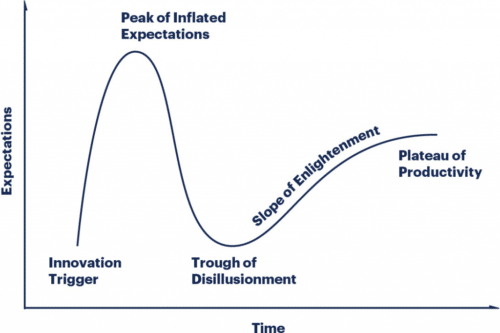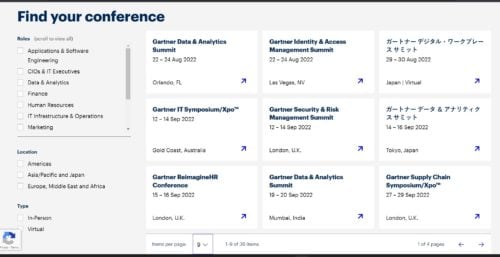Gartner
Gartner is a world-renowned information technology (IT) consultancy and advisory firm that conducts research on different technologies and provides insights to clients for smarter decision-making and stronger performance. Read on to learn more about Gartner and the products and services the organization offers here.
In this definition...
What Is Gartner?
Gartner is a leading research and advisory company that provides actionable insights, advice, and tools for leaders in IT, finance, HR, customer service, and support. Founded in 1979, Gartner has over 15,000 employees in 100 countries and is a publicly-traded company on the New York Stock Exchange. Gartner follows rigorous methodologies to conduct in-depth market research, helping business leaders make strategic decisions to move ahead of their competition.
What Does Gartner Do for Its Customers?
Gartner delivers data-driven insights to clients to help them make smarter technology and business decisions. With its expert guidance, tools, and consultation, Gartner has been a valuable partner to its customers: CIOs, technology investors, senior IT leaders in enterprises, government agencies, business leaders in high-tech and telecom corporations, and professional services firms.
Gartner is best known for its Magic Quadrant reports, which provide in-depth analysis of different technology companies and products. Other Gartner tools include Hype Cycle, BuySmart, Digital IQ, Product Decisions, and Critical Capabilities.
Gartner Research and Advisory, as well as Gartner consulting services, enable businesses to make informed decisions that accelerate business growth. Gartner Conferences equip IT and business leaders with peer networking, as well as exclusive invites to attend symposiums and gain strategic insights from thought leaders.
What Tools Does Gartner Offer Its Customers?
Gartner tools are software products and services designed to help businesses with a variety of tasks, from market research and analysis to lead generation and business intelligence.
Magic Quadrant
Gartner’s Magic Quadrant is a tool that businesses use to evaluate the relative strengths and weaknesses of different vendors in a given market. The Quadrant is divided into four sections, each of which represents a different level of performance: Leaders, Challengers, Visionaries, and Niche Players.
- Leaders are considered the top performers in the market who execute well today and are well-positioned for tomorrow. They are in the top-right quadrant of the Magic Quadrant.
- Challengers perform well today but don’t have a clear market direction for tomorrow. They are in the top-left quadrant of the Magic Quadrant.
- Visionaries are innovative companies with a strong vision of how the market will evolve but do not yet execute at the same level as the top players. They are in the bottom-right quadrant of the Magic Quadrant.
- Niche Players are companies that focus on a small market segment and do not outperform others but still have somewhat of a following. They are in the bottom-left quadrant of the Magic Quadrant.

Critical Capabilities
Gartner Critical Capabilities is an extended functionality of the Magic Quadrant. It offers deeper insights into providers’ product and service offerings based on different use cases. A Critical Capabilities document is a comparative analysis that rates competing products or services against use cases. It suggests which of these to add to the vendor shortlist for further evaluation and RFP.
Hype Cycle
Hype cycle is a graphical representation of different stages of a technology—how it evolves over time (or is expected to evolve over time) and its commercial viability. This visualization helps users separate the hype from real commercial drivers, understand the risks, grab opportunities, and make objective decisions. The hype cycle moves through five phases with a new technology release:
1. Innovation trigger: A technological breakthrough or product launch gets people talking.
2. Peak of inflated expectations: Early adopters implement the technology and either succeed or fail.
3. Trough of disillusionment: Early adopters face failures and report performance issues.
4. Slope of enlightenment: Early adopters begin to understand the technology and see the benefits. Others follow and implement it in their organizations.
5. Plateau of productivity: Mainstream adoption of the innovation begins.

Product Decisions
The Gartner Product Decisions tool helps product managers create a strong product strategy and roadmap with over 1 million live data points. It combines the power of Gartner proprietary buyer data, peer insights on buyers’ needs, and product capabilities across 100+ markets. By using over 20 algorithms, Product Decisions extracts, prioritizes, and analyzes potential product features and capabilities to provide accurate solutions.
BuySmart
Gartner BuySmart supports smart technology-buying decisions throughout the buyer’s journey. It helps businesses assess their strategic and technical requirements, pick the right vendor, follow optimal pricing models, and reduce complexity and risk. With in-depth analysis of contract terms and conditions, it protects organizations from future price hikes and unanticipated costs.
Digital IQ
Gartner Digital IQ index provides data-driven recommendations to improve performance against competitors. It helps businesses perform a digital SWOT analysis to identify areas of improvement and build a strategic roadmap. With channel performance analysis, brands can dig deeper across four dimensions: digital marketing channels, sites and applications, social media, and the path to purchase.
Gartner Digital Execution Scorecard
Gartner Digital Execution Scorecard equips CIOs and IT executives with an extensive set of digital strategy benchmarks. It unites IT functions with the C-suite and board members through a common language and engaging visuals to understand and achieve digital priorities. CIOs can use the scorecard to measure their performance against the benchmarks, identify gaps, and improve KPIs.
What Is Gartner Research & Advisory?
With Gartner Research & Advisory, enterprise leaders can achieve their organization’s most important objectives and stay ahead of the competition. Gartner’s proprietary tools, research, and expert guidance help businesses maximize ROI.
Gartner Research & Advisory offers the following:
- Comprehensive technology coverage related to clients’ needs.
- Personalized consultation and expert advice.
- Data-based tools, benchmarks, and guidebooks.
- A global network of peers and connection opportunities.
- Other resources informed by in-depth research and analysis.
What Are Gartner Conferences?
At Gartner conferences, IT and business leaders come together from around the world to network with peers, exchange key ideas and perspectives on industry trends, and formulate new business growth strategies. Gartner informs its network about symposium schedules and other conference details via email. These conferences are categorized based on different roles, locations, and types. Some events are traditional and in-person, while others are virtual or hybrid events.

What Is Gartner Consulting?
Gartner is a trusted advisor to over 15,000 enterprises in 100+ countries. Gartner Consulting helps CIOs and IT leaders achieve business outcomes as they relate to IT infrastructure. These are the primary categories of consulting solutions that Gartner offers:
Benchmark Analytics
By combining market-driven data with Gartner expert insights, business leaders can assess where they are today and opportunities for growth. Gartner Benchmark Analytics solutions are divided into internal operations and market perspective.
Internal operations benchmarks measure budget baseline, application productivity and operational costs, infrastructure cost, security risk, and customer satisfaction. Market perspective benchmarks include market price baseline, contract price competitiveness, service catalog rates, and business effectiveness.
Strategic Consulting
Gartner Strategic Consulting solutions fuel business growth with a solid strategy that harnesses IT infrastructure and establishes optimal processes and procedures. These solutions include digital acceleration, enterprise enablement, cost optimization, security and risk management, and technology market growth.
Contract Optimization
With contract optimization, Gartner helps businesses select the best products and services with optimized prices and terms. Gartner contract optimization aims to reduce operating costs and optimize capital deployment, mitigate risks in IT contracts, decrease cycle times and costs, and build working relationships with key suppliers.


